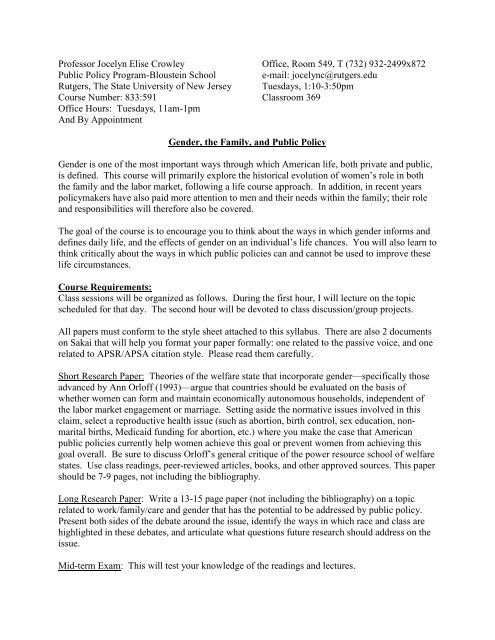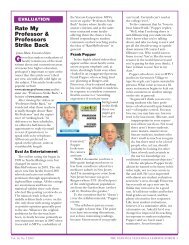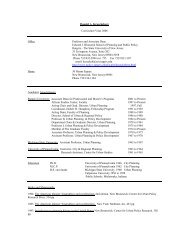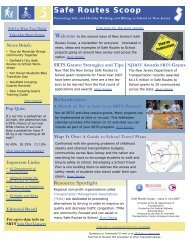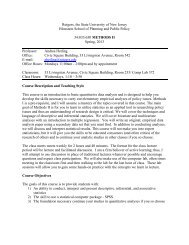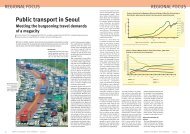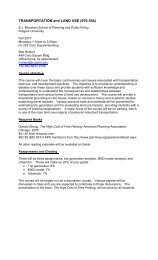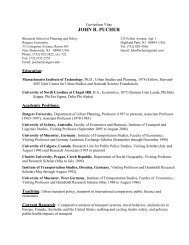Professor Jocelyn Elise Crowley - Bloustein School of Planning and ...
Professor Jocelyn Elise Crowley - Bloustein School of Planning and ...
Professor Jocelyn Elise Crowley - Bloustein School of Planning and ...
Create successful ePaper yourself
Turn your PDF publications into a flip-book with our unique Google optimized e-Paper software.
<strong>Pr<strong>of</strong>essor</strong> <strong>Jocelyn</strong> <strong>Elise</strong> <strong>Crowley</strong> Office, Room 549, T (732) 932-2499x872<br />
Public Policy Program-<strong>Bloustein</strong> <strong>School</strong> e-mail: jocelync@rutgers.edu<br />
Rutgers, The State University <strong>of</strong> New Jersey Tuesdays, 1:10-3:50pm<br />
Course Number: 833:591 Classroom 369<br />
Office Hours: Tuesdays, 11am-1pm<br />
And By Appointment<br />
Gender, the Family, <strong>and</strong> Public Policy<br />
Gender is one <strong>of</strong> the most important ways through which American life, both private <strong>and</strong> public,<br />
is defined. This course will primarily explore the historical evolution <strong>of</strong> women’s role in both<br />
the family <strong>and</strong> the labor market, following a life course approach. In addition, in recent years<br />
policymakers have also paid more attention to men <strong>and</strong> their needs within the family; their role<br />
<strong>and</strong> responsibilities will therefore also be covered.<br />
The goal <strong>of</strong> the course is to encourage you to think about the ways in which gender informs <strong>and</strong><br />
defines daily life, <strong>and</strong> the effects <strong>of</strong> gender on an individual’s life chances. You will also learn to<br />
think critically about the ways in which public policies can <strong>and</strong> cannot be used to improve these<br />
life circumstances.<br />
Course Requirements:<br />
Class sessions will be organized as follows. During the first hour, I will lecture on the topic<br />
scheduled for that day. The second hour will be devoted to class discussion/group projects.<br />
All papers must conform to the style sheet attached to this syllabus. There are also 2 documents<br />
on Sakai that will help you format your paper formally: one related to the passive voice, <strong>and</strong> one<br />
related to APSR/APSA citation style. Please read them carefully.<br />
Short Research Paper: Theories <strong>of</strong> the welfare state that incorporate gender—specifically those<br />
advanced by Ann Orl<strong>of</strong>f (1993)—argue that countries should be evaluated on the basis <strong>of</strong><br />
whether women can form <strong>and</strong> maintain economically autonomous households, independent <strong>of</strong><br />
the labor market engagement or marriage. Setting aside the normative issues involved in this<br />
claim, select a reproductive health issue (such as abortion, birth control, sex education, nonmarital<br />
births, Medicaid funding for abortion, etc.) where you make the case that American<br />
public policies currently help women achieve this goal or prevent women from achieving this<br />
goal overall. Be sure to discuss Orl<strong>of</strong>f’s general critique <strong>of</strong> the power resource school <strong>of</strong> welfare<br />
states. Use class readings, peer-reviewed articles, books, <strong>and</strong> other approved sources. This paper<br />
should be 7-9 pages, not including the bibliography.<br />
Long Research Paper: Write a 13-15 page paper (not including the bibliography) on a topic<br />
related to work/family/care <strong>and</strong> gender that has the potential to be addressed by public policy.<br />
Present both sides <strong>of</strong> the debate around the issue, identify the ways in which race <strong>and</strong> class are<br />
highlighted in these debates, <strong>and</strong> articulate what questions future research should address on the<br />
issue.<br />
Mid-term Exam: This will test your knowledge <strong>of</strong> the readings <strong>and</strong> lectures.
Grades will be calculated based on points as follows:<br />
A. Class Participation: 10 points total<br />
B. 1 Short Research Paper: 20 points<br />
1 Mid-term: 20 points<br />
1 Long Research Paper: 40 points<br />
1 Oral presentation based on this long paper: 10 points<br />
GRADING POLICY: 90-100:A; 87-89:B+; 80-86:B; 77-79:C+; 70-76:C; 69 <strong>and</strong> below is a<br />
failing grade. Plagiarism is the outright copying <strong>of</strong> someone’s words, or the use <strong>of</strong> someone’s<br />
ideas, writings, or data without proper attribution. University policy states that plagiarism <strong>of</strong> any<br />
kind can result in an F for the class; plagiarism is also considered a Level 4 separable <strong>of</strong>fense<br />
from the University. You are responsible for reading <strong>and</strong> underst<strong>and</strong>ing all policies related to<br />
academic integrity at Rutgers University. Please consult http://academicintegrity.rutgers.edu/ to<br />
review these policies. All students must upload their papers to the Assignments box on Sakai<br />
where they will be scanned for plagiarism using Turnitin.com. Unless requested, all assignments<br />
must also be turned in via hard copy.<br />
Late Penalties: There will be a 3 point penalty per day for late writing assignments. Papers<br />
must be turned in within the first 5 minutes <strong>of</strong> class or they are considered late.<br />
The following required books must be purchased at the bookstore on Albany Street. All other<br />
readings <strong>and</strong> cases will be available on Sakai: http://sakai.rutgers.edu/ EXCEPT cases from the<br />
Harvard JFK <strong>School</strong> Case program. These cases must be purchased individually from the<br />
website: http://www.ksgcase.harvard.edu/. All cases <strong>and</strong> their associated worksheets must be<br />
printed out, read, <strong>and</strong> brought to class.<br />
Required Books:<br />
Williams, Joan. 2010. Reshaping the Work-Family Debate. Cambridge: Harvard University<br />
Press.<br />
Gornick, Janet.C. <strong>and</strong> Marcia K. Meyers. 2003. Families that Work: Policies for Reconciling<br />
Parenthood <strong>and</strong> Employment. New York: Russell Sage Foundation Press.<br />
Meyer, Madonna Harrington <strong>and</strong> Pamela Herd. 2007. Market Friendly or Family Friendly? The<br />
State <strong>and</strong> Gender Inequality in Old Age. New York: Russell Sage Foundation.<br />
I. Introduction: Course Overview. The Social Construction <strong>of</strong> Gender <strong>and</strong> its Relationship to<br />
the Family. Week 1 (January 18)<br />
II. Theories <strong>of</strong> Gender, the Family, <strong>and</strong> the State: Week 2 (January 25).<br />
Orl<strong>of</strong>f, Ann. 1993. “Gender <strong>and</strong> the Social Rights <strong>of</strong> Citizenship: The Comparative Analysis <strong>of</strong><br />
Gender Relations <strong>and</strong> Welfare States.” American Sociological Review 58 (June):303-328.<br />
Orl<strong>of</strong>f, Ann Shola <strong>and</strong> Renee Monson. 2002. “Citizens, Workers, or Fathers? Men in the History<br />
<strong>of</strong> US Social Policy.” In Making Men into Fathers: Men Masculinities, <strong>and</strong> the Social Politics <strong>of</strong><br />
Fatherhood, ed. Barbara Hobson. Cambridge: Cambridge University Press.<br />
Williams, Introduction.
CASE: “HEW <strong>and</strong> Title IX: The Elimination <strong>of</strong> Sex Discrimination in Education”-Kennedy<br />
<strong>School</strong> Case 155.<br />
II. To Have Children, or not to Have Children: That is the Question<br />
A. Reproductive Rights, Birth Control, Sex Education, <strong>and</strong> Abortion: Week 3 (February 1).<br />
Tone, Andrea, ed. 1997. Controlling Reproduction. Wilmington, DE: Scholarly Resources.<br />
Parts V. <strong>and</strong> VI.<br />
Strickler, Jennifer <strong>and</strong> Nicholas L. Danigelis. 2002. “Changing Frameworks in Attitudes Toward<br />
Abortion.” Sociological Forum 17(2): 187-201.<br />
Roback Morse, Jennifer. 2001. Love <strong>and</strong> Economics: Why the Laissez-Faire Family Doesn’t<br />
Work. Dallas: Spence, Chp. 5.<br />
Williams, Chp. 1<br />
CASE: “Cocaine Mothers”-Kennedy <strong>School</strong> Case C16-90-944.0<br />
B. Nonmarital Births: Week 4 (February 8).<br />
Ciabattari, Teresa. 2006. “Single Mothers <strong>and</strong> Family Values: The Effects <strong>of</strong> Welfare, Race, <strong>and</strong><br />
Marriage on Family Attitudes.” In Families <strong>and</strong> Social Policy: National <strong>and</strong> International<br />
Perspectives, Edited by Linda Haas <strong>and</strong> Steven K. Wisensale. New York: Haworth.<br />
Roback Morse, Jennifer. 2001. Love <strong>and</strong> Economics: Why the Laissez-Faire Family Doesn’t<br />
Work. Dallas: Spence., Chp. 6.<br />
Wu, Lawrence L., Larry L. Bumpass, <strong>and</strong> Kelly Musick. 2001. “Historical <strong>and</strong> Life Course<br />
Trajectories <strong>of</strong> Nonmarital Childbearing.” In Out-<strong>of</strong>-Wedlock, Edited by Lawrence L. Wu <strong>and</strong><br />
Barbara Wolfe. New York: Russell Sage Press.<br />
Williams, Chp. 2.<br />
CASE: “Buying Time-The Dollar a Day Program”-Kennedy <strong>School</strong> Case C16-90-961.<br />
III. Gender <strong>and</strong> Parenting Challenges in America: Paper #1 Due (short paper)<br />
A. Women <strong>and</strong> Work: A Brief History: Week 6 (February 15).<br />
Gornick <strong>and</strong> Meyers, Chapters 1, 2, <strong>and</strong> 4.<br />
Williams, Chp. 3.<br />
CASE: “Women in the Navy” –Kennedy <strong>School</strong> Case C16-88-853.0<br />
B. Household Labor. Week 7 (February 22).<br />
Bianchi, Suzanne M., Robinson, John P. And Melissa A. Milkie. 2006. Changing Rhythms <strong>of</strong><br />
American Family Life. New York: Russell Sage Foundation. Chapters 1, 3, 4, <strong>and</strong> 10.<br />
Williams, Chapter 4.<br />
CASE: Chapter 8 from Hochschild, Arlie Russell. 2003. The Second Shift.<br />
New York: Penguin Books. (available on Sakai)<br />
C. Workplace Flexibility <strong>and</strong> Family Leave: Week 8 (March 1).<br />
Roback Morse, Jennifer. 2001. Love <strong>and</strong> Economics: Why the Laissez-Faire Family Doesn’t<br />
Work. Dallas: Spence, Chp. 7.<br />
Williams, Chp. 5.<br />
Gornick <strong>and</strong> Meyers, Chapter 5.<br />
CASE: “Proving Leo Durocher Wrong: Driving Work/Life Change at Ernst <strong>and</strong> Young”<br />
(available on Sakai)
D. Child Care, Early Preschool Education, <strong>and</strong> After <strong>School</strong> Care. Week 9 (March 8).<br />
Williams, Chp. 6.<br />
Gornick <strong>and</strong> Meyers, Chapter 7.<br />
Roback Morse, Jennifer. 2001. Love <strong>and</strong> Economics: Why the Laissez-Faire Family Doesn’t<br />
Work. Dallas: Spence, Chp. 8.<br />
CASE: “The Georgia Early Learning Initiative”-Kennedy <strong>School</strong> Case 1683.<br />
E. When Families Dissolve: Child Support <strong>and</strong> Child Custody: Week 10 (March 22).<br />
Williams, Conclusion.<br />
<strong>Crowley</strong>, <strong>Jocelyn</strong> <strong>Elise</strong>. 2003. The Politics <strong>of</strong> Child Support in America. New York:<br />
Cambridge University Press. Chapter 2.<br />
<strong>Crowley</strong>, <strong>Jocelyn</strong> <strong>Elise</strong>. 2006. "Organizational Responses to the Fatherhood Crisis: The Case <strong>of</strong><br />
Fathers' Rights Groups in the United States." Marriage <strong>and</strong> Family Review. 39(1/2): 99-120;<br />
Reprinted in Families <strong>and</strong> Social Policy: National <strong>and</strong> International Perspectives, edited by<br />
Linda Haas <strong>and</strong> Steven K. Wisensale. 2006. New York: Haworth Press.<br />
CASE: GAO Report 98-168: “Child Support an Uncertain Income Supplement for Families<br />
Leaving Welfare” (available on Sakai)<br />
Mid term: March 29<br />
IV. Women, Aging, <strong>and</strong> the Family<br />
A. Women <strong>and</strong> Retirement from Paid Work: Week 11 (April 5).<br />
Williams, Chp. 8.<br />
Meyer <strong>and</strong> Herd, Chp. 1-4.<br />
CASE: GAO Report 08-105: “Retirement Security: Women Face Challenges in Ensuring<br />
Financial Security in Retirement” (available on Sakai)<br />
B. Women’s Health as They Age <strong>and</strong> Carework for the Aged: Week 12 (April 12).<br />
CASE: GAO Report 02-1131T: “Long Term Care” (available on Sakai)<br />
Meyer <strong>and</strong> Herd, Chp. 5-7.<br />
V. What are we Going to Do About it? Week 13 (April 19).<br />
Gornick, Janet C. <strong>and</strong> Marcia K. Meyers. 2009. “Institutions that Support Gender Equality in<br />
Parenthood <strong>and</strong> Employment.” In Gender Equality: Transforming Family Divisions <strong>of</strong> Labor,<br />
Edited by Janet C. Gornick <strong>and</strong> Marcia K. Meyers. New York: Verso Press.<br />
WEEK 14. CLASS PRESENTATIONS –Second Long Paper Due (April 26)
WRITING A PAPER: Style Sheet<br />
“Tell me what you are going to tell me. Tell me. Tell me what you told me.”<br />
1. Underst<strong>and</strong> the Question. Make sure you are prepared to answer the question.<br />
2. Make an Argument: This involves taking a st<strong>and</strong> on an issue <strong>and</strong> marshalling evidence to<br />
support the st<strong>and</strong>.<br />
3. Outline A. First paragraph- I should know what your argument is. Hit me over the head<br />
with it. Also, provide me with a road map <strong>of</strong> your paper.<br />
B. The body <strong>of</strong> paper should include your points <strong>of</strong> pro<strong>of</strong>. Please transition between<br />
paragraphs.<br />
C. Last Paragraph-Make sure you include a solid conclusion. Repeat thesis. Add to<br />
thesis.<br />
STYLE<br />
1. Avoid run-on sentences, general reflections, <strong>and</strong> the passive voice (see Sakai<br />
for examples <strong>of</strong> the passive voice).<br />
2. Follow basic format requirements exactly. This means 10/12 pt font, one inch<br />
margins, page numbers, <strong>and</strong> double-spaced.<br />
3. Always spell check, spell out numbers less than ten, <strong>and</strong> keep to the paper’s<br />
length (except tables <strong>and</strong> graphs should be called Table 1 <strong>and</strong> Graph 1, for<br />
example).<br />
4. Always include an alphabetized bibliography.<br />
5. CITATIONS: You must cite your sources within the text in the following<br />
format (Author Year, Page Number) or (Author Year)-if no page number is<br />
appropriate. EXAMPLE: “I love the word Blah” (Brown 1999, 56). Note that<br />
the period comes after the parentheses. Please consult 1998 or later version <strong>of</strong><br />
the American Political Science Review (APSR) for appropriate format (also<br />
known as APSA Style). You can examine articles with their citation styles by<br />
accessing APSR through the JSTOR online journal database available at the<br />
Rutgers University Libraries website. Cite ideas that are not your own, quotes,<br />
statistics, etc. You should include the complete citation for Brown in the<br />
alphabetized bibliography. See Sakai for examples <strong>of</strong> proper citation style.<br />
6. Do not string together a series <strong>of</strong> quotes. Use your own words. If you must<br />
use quotes, follow these guidelines. If the quote is under 3 lines, use<br />
quotation marks. Example: “If I do not use quotation marks correctly, Pr<strong>of</strong>.<br />
<strong>Crowley</strong> will go crazy.”<br />
More on quotes: If the quote is more than 3 lines, indent it, single space it,<br />
<strong>and</strong> do not use quotation marks. Example:<br />
The meaning <strong>of</strong> Blah is simple. You simply need to address all aspects <strong>of</strong><br />
the word. Blah can be used in a variety <strong>of</strong> different circumstances. Most<br />
<strong>of</strong> us would like to use the word Blah all <strong>of</strong> the time because it is better<br />
than Yada, Yada, Yada (Brown 1999, 56).<br />
7. Avoid contractions, informal language, <strong>and</strong> weak words like “feel,” “says,”<br />
“believe,” “seem,” “get,” <strong>and</strong> “appear.”<br />
8. Identify interest groups as having a particular political leaning if they have<br />
one (i.e., the Heritage Foundation, a conservative think tank,..)<br />
9. Underline or italicize book, journal, <strong>and</strong> newspaper titles in the text, footnotes,<br />
<strong>and</strong> bibliography.
10. Members <strong>of</strong> Congress should be identified the first time they appear in your<br />
paper as follows: Robert Torricelli (D-NJ), <strong>and</strong> thereafter as simply Torricelli<br />
or Senator Torricelli.<br />
11. Do not identify scholars as pr<strong>of</strong>essors, but rather as a member <strong>of</strong> their field.<br />
(i.e., political scientist John Kingdon, NOT <strong>Pr<strong>of</strong>essor</strong> John Kingdon)<br />
12. Use footnotes to cite statistics, explain data, <strong>and</strong> to provide the reader with<br />
more info. Footnotes should be placed at the end <strong>of</strong> the sentence.<br />
13. Always capitalize Congress, President, House, House <strong>of</strong> Representatives, <strong>and</strong><br />
Senate.<br />
14. Do not end sentences with a preposition.<br />
RESOURCES:<br />
Rutgers University Learning Center: This Center will help you edit <strong>and</strong> rewrite your papers. Contact:<br />
Shawn Taylor in room 205A at the Regina B. Heldrich Science Bld. on Douglass Campus. Email him at<br />
sktaylor@ rutgers.edu or call him at 732-932-2732.


